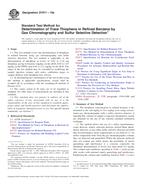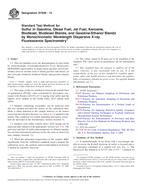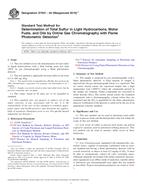We need your consent to use the individual data so that you can see information about your interests, among other things. Click "OK" to give your consent.
ASTM D6986-03(2010)
Standard Test Method for Free Water, Particulate and Other Contamination in Aviation Fuels (Visual Inspection Procedures)
STANDARD published on 1.7.2010
The information about the standard:
Designation standards: ASTM D6986-03(2010)
Note: WITHDRAWN
Publication date standards: 1.7.2010
SKU: NS-37216
The number of pages: 5
Approximate weight : 15 g (0.03 lbs)
Country: American technical standard
Category: Technical standards ASTM
The category - similar standards:
Annotation of standard text ASTM D6986-03(2010) :
Keywords:
aviation fuel appearance, free water, particulates, product contamination, sample containers, white bucket, Aviation fuels, Contamination--petroleum products, Free water contamination, Particulate contamination, Visual examination--petroleum products, ICS Number Code 75.160.20 (Liquid fuels)
Additional information
| Significance and Use | ||||||||||
|
The two procedures in the test method provide rapid methods for field detection of free water and solid contaminants, or any other visually apparent contamination. Uncertain or marginal results by either of these methods would normally result in the performance of methods such as D2276, D5452, or D3240 for quantitative determination of contaminants. Particulate determination in appearance tests is sensitive to sampling procedures. The presence of a small number of particles may indicate, for example, that the sample line was not flushed to provide a representative sample. The persistent presence of even a small number of particles, however, may be cause for further investigation depending on the situation. Experience has shown that an experienced tester using a clear bottle can detect as little as 40 ppm of free, suspended water in the fuel. Thus, a fuel rated as clear and bright can still fail lower limits set by quantitative methods. A rater will also have difficulty resolving particles smaller than 40 μm. Smaller particles must be determined by other than visual methods such as D2276, D5452 or chemical field tests listed in Manual 5. Experience has shown the visual appearance of fuel in a white porcelain bucket to be the most suitable method for the detection of dye contamination or other unusual discoloration. In the U. S., the white porcelain bucket is used to detect the dye. |
||||||||||
| 1. Scope | ||||||||||
|
1.1 This test method covers two procedures for establishing the presence of suspended free water, solid particulate, and other contaminants in aviation gasoline and aviation turbine fuels. 1.1.1 Both procedures are intended primarily for use as field tests with the fuel at handling temperature. 1.1.2 Procedure A uses transparent sample containers; Procedure B uses opaque containers. 1.2 Both procedures are rapid methods for contamination detection and include ratings of haze appearance and particulate presence. 1.3 The values stated in SI units are to be regarded as the standard. The values given in parentheses are for information only. |
||||||||||
| 2. Referenced Documents | ||||||||||
|
Similar standards:
Historical
1.6.2010
Historical
15.9.2013
Historical
1.5.2010
Historical
1.5.2014
Historical
1.11.2012
Historical
15.2.2010
We recommend:
Updating of laws
Do you want to be sure about the validity of used regulations?
We offer you a solution so that you could use valid and updated legislative regulations.
Would you like to get more information? Look at this page.



 ASTM D7011-10a
ASTM D7011-10a ASTM D7039-13
ASTM D7039-13 ASTM D7041-04(2010)e..
ASTM D7041-04(2010)e.. ASTM D7058-04(2014)..
ASTM D7058-04(2014).. ASTM D7060-12
ASTM D7060-12 ASTM D7096-10
ASTM D7096-10
 Cookies
Cookies
